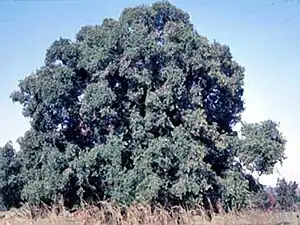mũgumo
Kikuyu

mũgumo (F. thonningii)
Pronunciation
- IPA(key): /mòɣùmɔ̀(ꜜ)/
- As for Tonal Class, Benson (1964) classifies this term into Class 1 with a disyllabic stem, together with ndaka, and so on.
- (Kiambu)
- (Limuru) As for Tonal Class, Yukawa (1981) classifies this term into a group including cindano, huko, iburi, igego, igoti, ini (pl. mani), inooro, irigũ, irũa, iturubarĩ (pl. maturubarĩ), kĩbaata, kĩmũrĩ, kũgũrũ, mũciĩ, mũgeni, mũgũrũki, mũmbirarũ, mũndũ, mũri, mũthuuri, mwaki (“fire”), mwario (“way of speaking”), mbogoro, nda, ndaka, ndigiri, ngo, njagathi, njogu, nyondo (“breast(s)”), and so on.[2]
Noun
mũgumo class 3 (plural mĩgumo)
See also
- mũkũyũ, mũũmbũ
References
- Hutchins, D. E. (1909). Report on the Forests of British East Africa, p. 24. London: Darling & Son.
- Yukawa, Yasutoshi (1981). "A Tentative Tonal Analysis of Kikuyu Nouns: A Study of Limuru Dialect." In Journal of Asian and African Studies, No. 22, 75–123.
- “mũgumo” in Benson, T.G. (1964). Kikuyu-English dictionary, p. 122. Oxford: Clarendon Press.
- Napoli, Donna Jo (2010). Mama Miti: Wangari Maathai and the Trees of Kenya. Simon & Schuster.
- Dharani, Najma (2002). Field Guide to Common Trees & Shrubs of East Africa, p. 113. Cape Town: Struik Publishers. Rep. 2005. →ISBN
- Dharani, op. cit., p. 110.
- A Guide to Trees in Kenya Useful for Agroforestry. (Retrieved 11 December 2017)
This article is issued from Wiktionary. The text is licensed under Creative Commons - Attribution - Sharealike. Additional terms may apply for the media files.